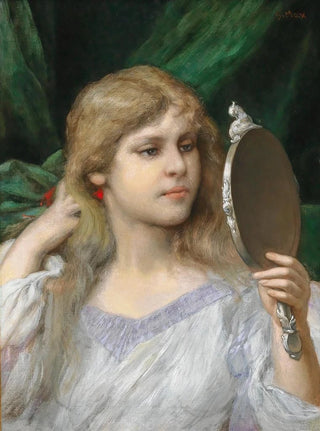Art print | The Mirror - Gabriel von Max


View from behind

Frame (optional)
Reproduction The Mirror - Gabriel von Max – Captivating Introduction
In the fascinating universe of art, some works manage to capture the very essence of the human soul. "The Mirror" by Gabriel von Max is a shining example. Painted at the end of the 19th century, this painting evokes an inner dialogue, an introspection that resonates with anyone who lingers on it. The piece immerses us in a world where reality and imagination intertwine, where reflection becomes a metaphor for the quest for self. The composition, both delicate and powerful, invites the viewer to question their own image and the multiple facets of their personality.
Style and uniqueness of the work
Gabriel von Max's style is distinguished by his ability to blend realism with a touch of symbolism. In "The Mirror," the meticulous details of faces and textures combine with a dreamlike atmosphere, creating a unique visual experience. The color palette chosen by the artist, oscillating between dark shades and luminous highlights, emphasizes this duality between shadow and light. The characters, caught in a contemplative posture, seem captured in a moment of intense reflection, making the scene all the more poignant. This work is not just a simple painting; it becomes a window into the thoughts and emotions of the human being, a mirror of our own inner struggles.
The artist and his influence
Gabriel von Max, painter and sculptor of Austrian origin, managed to carve out a prominent place in the artistic landscape of his time. Influenced by the symbolist movement, he explored themes such as psychology, spirituality, and human nature. His innovative approach allowed him to transcend the conventions of his era, bringing emotional depth to his works. Von Max was also a passionate advocate for art as a tool for reflection and questioning. His legacy endures through his creations, which continue to inspire generations of artists and art lovers. "The Mirror" thus presents not only as an emblematic work of his talent but also as a testament to his commitment to exploring the complexities of the human soul.
A wall decoration

Matte finish

View from behind

Frame (optional)
Reproduction The Mirror - Gabriel von Max – Captivating Introduction
In the fascinating universe of art, some works manage to capture the very essence of the human soul. "The Mirror" by Gabriel von Max is a shining example. Painted at the end of the 19th century, this painting evokes an inner dialogue, an introspection that resonates with anyone who lingers on it. The piece immerses us in a world where reality and imagination intertwine, where reflection becomes a metaphor for the quest for self. The composition, both delicate and powerful, invites the viewer to question their own image and the multiple facets of their personality.
Style and uniqueness of the work
Gabriel von Max's style is distinguished by his ability to blend realism with a touch of symbolism. In "The Mirror," the meticulous details of faces and textures combine with a dreamlike atmosphere, creating a unique visual experience. The color palette chosen by the artist, oscillating between dark shades and luminous highlights, emphasizes this duality between shadow and light. The characters, caught in a contemplative posture, seem captured in a moment of intense reflection, making the scene all the more poignant. This work is not just a simple painting; it becomes a window into the thoughts and emotions of the human being, a mirror of our own inner struggles.
The artist and his influence
Gabriel von Max, painter and sculptor of Austrian origin, managed to carve out a prominent place in the artistic landscape of his time. Influenced by the symbolist movement, he explored themes such as psychology, spirituality, and human nature. His innovative approach allowed him to transcend the conventions of his era, bringing emotional depth to his works. Von Max was also a passionate advocate for art as a tool for reflection and questioning. His legacy endures through his creations, which continue to inspire generations of artists and art lovers. "The Mirror" thus presents not only as an emblematic work of his talent but also as a testament to his commitment to exploring the complexities of the human soul.
A wall decoration






